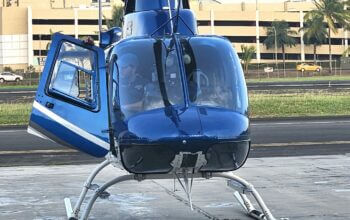Estimated reading time 4 minutes, 44 seconds.
FLYHT Aerospace Solutions Ltd. has announced positive results from the flight-test program of its Automated Flight Information Reporting System (AFIRS) on the Boeing ecoDemonstrator aircraft.
In conjunction with partners Boeing and Embraer, FLYHT presented the results of the tests to the Airlines Electronic Engineering Committee (AEEC) Global Aircraft Tracking (GAT) Working Group meeting in Kelowna, B.C.
The reported analysis and resulting conclusions are receiving a positive response.
This is the first time the data from an aircraft’s flight data recorder (FDR) has been streamed over a satellite network for the duration of a flight, thereby validating the black-box-in-the-cloud use case.
Additional first-time milestones included cockpit audio steaming, and the concurrent transmission of historical FDR and cockpit audio data and real-time data and audio.
Following the trials, the three partners concluded that, “Existing, commercially available equipment and network services (FLYHT’s AFIRS and Inmarsat SwiftBroadband) are suitable for providing distress flight data and audio streaming capabilities that support ICAO objectives.”
Additional, core findings include:
- Current equipment supports ICAO 10054 (International Civil Aviation Association) FDR and CVR (cockpit voice recorder) streaming recommendations;
- Inmarsat SwiftBroadband capabilities exceed bandwidth requirements to stream real-time and historical FDR and CVR data; and
- Limited bandwidth options such as the Iridium short burst data (SBD) services used in these tests can provide a useful flight-data-streaming capability.
“We are extremely proud to have the opportunity to collaborate with Boeing and Embraer on the ecoDemonstrator program,” said Thomas R. Schmutz, FLYHT CEO. “These test flights are highly valuable and the results are positive. This is another example of how we continue to demonstrate the value of FLYHT’s patented real-time aircraft data streaming. In this instance we validated its usefulness for distressed flight situations and support of the ICAO objectives for the Global Aeronautical Distress and Safety System mandate, or GADSS.”
The flight tests took place over 80 flight hours and the findings entitled, “Analysis of Flight Data Streaming Trials on the Boeing 2018 ecoDemonstrator,” developed in cooperation with Boeing and Embraer, will be available on the AEEC website.
“These tests highlight important findings for FLYHT, Boeing, Embraer and the ecoDemonstrator program,” said Derek Graham, FLYHT CTO. “Timely access to flight data and autonomous distress tracking are key capabilities for achieving compliance with the GADSS requirement, and we are gratified to see the tests validating the solution.”
Following the unfortunate accidents of flights AF447 and MH370, and in its search to find a solution that supports ICAO’s new GADSS–a system to track and report on aircraft location and status–the aviation industry has been testing technology applicable to the recovery of FDR data and locating aircraft in distress.
The standards and practices, which start to take effect as early as 2018, specify new capabilities for commercial aircraft operators, which may require newly installed equipment to comply with the ICAO GADSS mandate.
Anticipating these emerging standards, Boeing, FLYHT, and Embraer tested real-time data streaming technology installed on the Boeing 777 Freighter ecoDemonstrator aircraft.
Tests were designed to demonstrate the technology’s potential to support the timely recovery of flight recorder data. The trial activities used FLYHT’s AFIRS data streaming solution and both Iridium SBD, and Inmarsat SwiftBroadband satellite networks to stream–in real-time–data that is traditionally captured by the flight data recorder.
The goal was to evaluate the system’s ability to deliver functionality required for certain aspects of the ICAO standards. The data was captured in FLYHT’s UpTime™ Cloud server and also displayed as a 3D animation.
This allowed operators on the ground to view a virtual cockpit display of the pilots’ primary flight display (PFD), crucial engine gauges, and flight controls in near real-time.
Based on the solution’s proof-of-concept testing during the trials, it became evident that a Satcom-based solution combined with real-time, data streaming technology could be leveraged and developed to address the near-term requirements for aircraft tracking and autonomous distress tracking.
In addition, testing established the potential to address future post flight localization and data recovery requirements. Even in cases where the physical aircraft data cannot be immediately located, the data streamed off the airplane can provide a head start in accident investigation and perhaps even accident mitigation and recovery.
To learn more about GADSS, click here.








